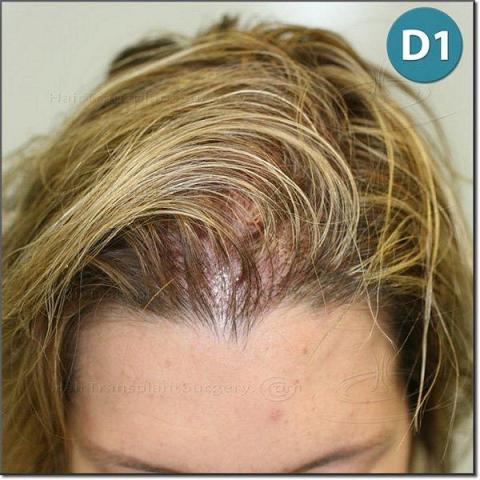Understanding Female Pattern Baldness and Hair Loss.
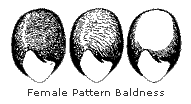
Female hair loss, often referred to as "Alopecia" is the visible result of thinning hair and baldness on the scalp. While thinning hair is typically thought of to be a condition that only men suffer from, more than 20 million women in the United States alone are suffer from it.
The process typically takes months and even years to complete. In fact, women can lose up to 50% of their existing hair in a concentrated area before there are visible signs of thinning hair.
Hair loss in women, while less common than hair loss in men, can be far more emotionally damaging. There are fewer hair regrowth options for women than there are for men and women often suffer the pain of thinning hair in more personal ways.
While women can suffer female pattern baldness with thinning in the crown, temples and hairline, they also are more likely to have a diffuse hair thinning pattern throughout the entire scalp which limits their hair restoration options.
Womens hair loss can be permanent or temporary. While temporary hair loss can be reversed within 12-24 months, other forms of female pattern baldness are permanent and can't be reversed.
What Causes Female Hair Loss?
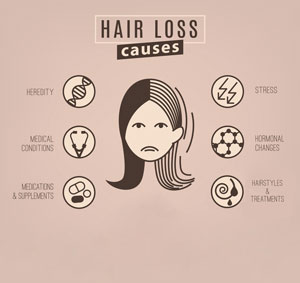
Just like men, women also suffer from different types of hair loss. Some of the common types include:
Telogen Effluvium
Any traumatic event such as severe infection, childbirth, malnutrition, etc. can impact your hair. More than 90% of the hair in the growing phase can shift into the resting phase, causing thinning and baldness.
Traction Alopecia
This condition can be the result of localized trauma to hair follicles because of tight ponytails, braids, cornrows, and extensions that pull hair over time.
Anagen Effluvium
This type of female hair loss is often associated with chemotherapy that not only targets the cancer cells but the hair follicles. More than 90% of hair fall out in this phase.
Scarring Alopecia
There are many skin conditions that can result in scarring. When the skin experiences scarring, the hair follicles in the affected area are replaced temporarily by scars. However, it results in irreversible and permanent hair loss.
Can Female Hair Loss Be Treated?

Although a significant percentage of women loss their hair, many women involved with our online community have restored their hair with the help of legitimate products, treatments, and hair restoration physicians. Treatment options are available, however, the options for women are more limited than those available to men.
The drug Propecia and similar DHT blocking drugs should not be taken by women due to the high risk of birth defects. However, the popular topical treatment Rogaine (minoxidil) can be used by women, and many women undergo hair restoration surgery to restore their hair.
For some women, the causes are much more complex than the classic "male pattern baldness". Thus, the proper diagnosis of the underlying cause is vital before any treatments are attempted.
If you suspect you are experiencing female hair loss, consult with one of our prescreened hair restoration physicians. You can also visit our discussion forum for more solutions and advice.
Do Hair Transplants Work for Women?
Hair transplant surgery can be an effective female hair loss treatment if the thinning is concentrated in a particular area, much like the classic "male pattern baldness" seen in men.
Current hair transplants are so natural that even a hair stylist cant tell. However, women who are suffering from diffuse hair loss throughout their head are generally not good candidates for hair transplant surgery.
3 Common Hair Transplant Techniques for Women.
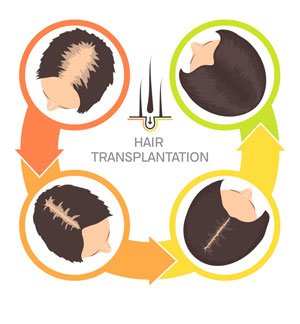
Today's state of the art hair transplant procedure is called follicular unit grafting and is so natural even a hairstylist cannot detect it. This procedure involves harvesting follicular units (hair groupings of 1 to 4 hairs as they occur naturally in the scalp) from the sides and back of the scalp (called the donor area) and implanting them into tiny recipient sites made by a skilled hair transplant surgeon in the balding areas.
There are several popular donor harvesting techniques and devices used today that are associated with follicular unit grafting. Some of them are listed below.
Follicular Unit Transplantation (FUT).
This process involves removing tissue from the sides and back of the scalp from which hair follicles are extracted. The extracted follicles are harvested by skilled professionals and transplanted to the balding recipient area. This donor harvesting technique in the hands of a skilled surgeon and experienced staff makes large hair transplant mega sessions and dense packing possible.
Follicular Unit Excision (FUE).
Formerly known as follicular unit extraction, this hair transplant technique is recommended for restoring hair in small areas or for those who want to wear their hair exceptionally short or cropped on the sides and back of their scalp. During this donor harvesting technique, follicular units are extracted from the donor one by one and transferred to the recipient. The hair follicles are usually implanted in groups of 1-4 hairs.
View photos of women who have undergone hair transplant surgery.
Direct Hair Transplant Technique.
This technique is one of the many variations of the follicular unit excision (FUE) procedure. The donor harvesting technique is essentially the same but how follicular units are implanted into the recipient site varies. In this case, a tool or device is used that prevents the need to touch the follicular unit. This is sometimes referred to as the "no touch" technique. Whether or not this particular technique is superior or inferior is debatable amongst hair restoration physicians. What matters most however, is the skill and experience of the surgeon, which implantation and excision device he or she uses.
Surgery to Lower the Hairline.
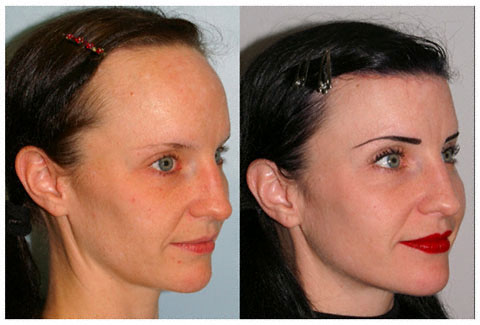
Some women naturally have a high hairline; however, this is not due to hair loss but rather due to heredity. Although transplanting hair to recreate a lower hairline is an option, such transplantation normally requires multiple sessions to create a hairline that is sufficiently dense.
There is an alternative surgical procedure that can lower the person's hairline in one session. This outpatient surgical hairline procedure involves excision excess tissue immediately below the existing hairline and then moving the hairline forward and down. This procedure can also be combined with a brow lift to give the patient additional benefits.
We Can Help You Find the Right Hair Loss Treatment.
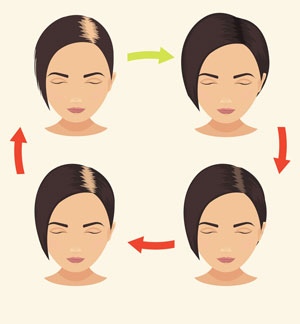
Our prescreened team of experienced surgeons are pioneers of the most advanced techniques and surgical hair restoration procedures for women. Visit our list of prescreened hair transplant surgeons. To see our standards for recommendation, click here.
During your initial consultation, our hair restoration surgeons will diagnose the cause and determine the best hair transplant treatment based on the type of hair loss, size of the balding area, and the availability of the donor.
Schedule a free consultation with one of our prescreened hair transplant surgeons to determine which procedure is best for you.
